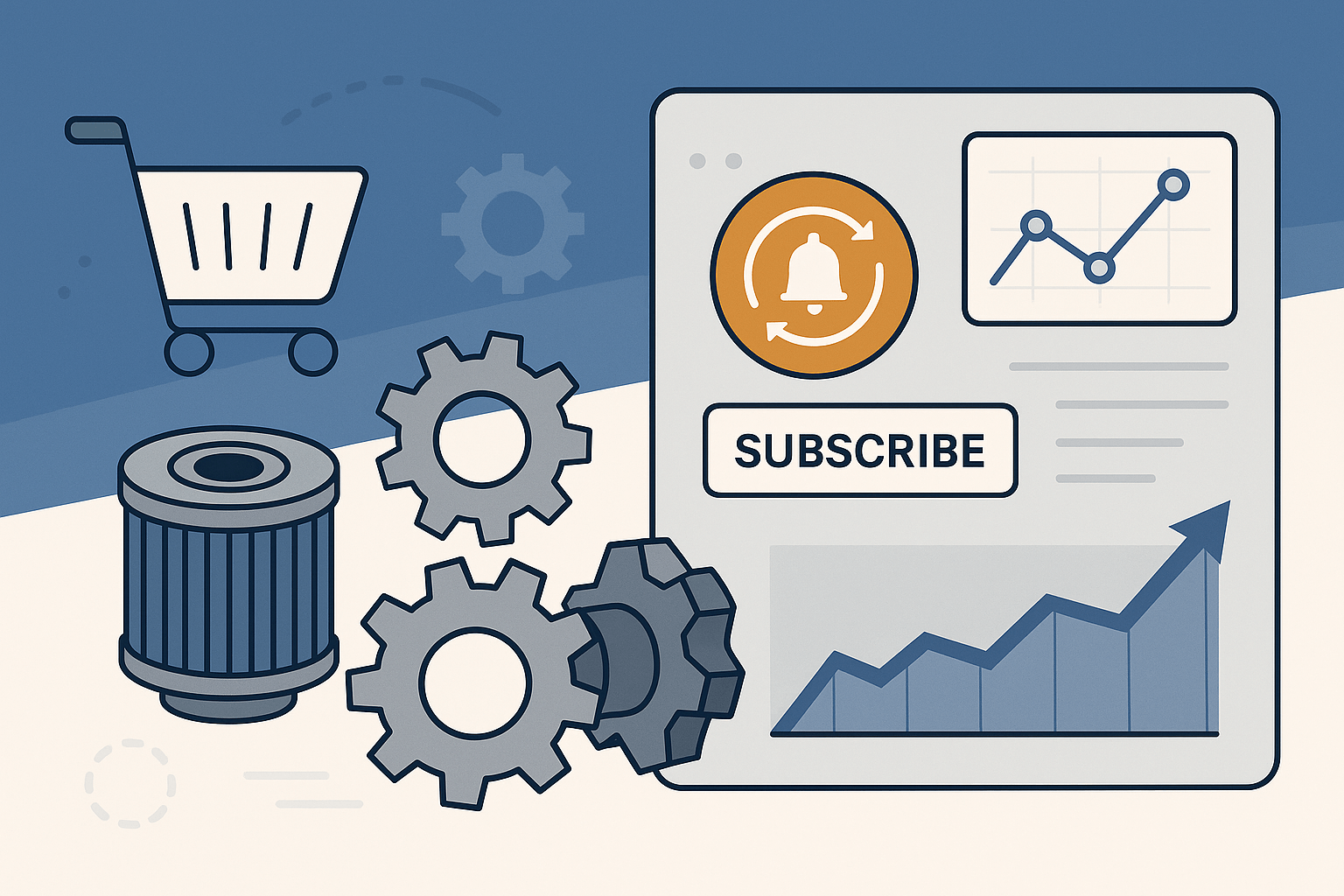The Subscription Gap in Heavy Equipment
Subscription commerce is everywhere, razors, dog food, coffee. Even B2B is catching on, with auto-ship programs for packaging, janitorial supplies, and printer toner. But when it comes to heavy machinery parts, most standard subscription systems fall flat. Why? Because the logic that powers them is too simplistic for the real-world conditions of industrial maintenance.
You can’t set a fixed 30-day reorder interval for a hydraulic seal on a CAT 336 excavator operating in double shifts in Arizona’s heat. Nor can you auto-ship a pressure relief valve for a centrifugal pump based on a calendar, especially if its wear rate depends on fluid type, operating pressure, and runtime hours logged by the plant manager. The conditions are too dynamic, and the stakes are too high. A missed part reorder isn’t an inconvenience. It’s costly downtime.
This gap is what’s holding back many industrial brands from adopting a replenishment model that works. They either bolt on rigid subscription apps designed for consumer goods or abandon the idea altogether, leaving retention on the table. Unlike custom subscription boxes in the consumer market, industrial parts need logic-driven replenishment built on runtime and machine metadata.
But there’s a better path forward: a custom subscription engine built around predictive maintenance logic. One that understands the machine, the part, and the usage conditions, and acts before failure or forgetfulness creates a problem. Built right, this system doesn’t just improve retention. It transforms your relationship with the buyer from vendor to operational ally.
This article will show you how to build that system inside BigCommerce with flexible product mapping, usage-based triggers, and reorder automation designed for the realities of heavy equipment workflows.
Why Standard Subscription Apps Don’t Work
Most off-the-shelf subscription platforms, whether native to BigCommerce or third-party tools like Recharge, Ordergroove, or Bold, are built around one core assumption: the customer wants a fixed product, delivered on a fixed schedule. Every 30 days. Every 90 days. Set it and forget it.
That works if you’re selling printer ink. It fails miserably if you’re trying to ship engine belts, seal kits, or hydraulic filters for heavy machinery.
The Failure of Fixed-Time Logic
Industrial parts don’t follow tidy cycles. A valve may last 200 hours in one piece of equipment and 800 in another, depending on pressure, fluid, vibration, or ambient temperature. Standard subscription engines can’t interpret these variables. They can’t even see them.
For example, let’s say a customer is operating two bulldozers — a CAT D6R and a Komatsu D61EX. Each requires different maintenance intervals. One’s working 16 hours a day in dust-heavy terrain. The other is idle every third day. What good is a flat 30-day replacement schedule? You’ll either send parts too early (waste) or too late (downtime).
No SKU-to-Machine Awareness
Another problem: generic subscription tools don’t understand product-to-machine relationships. They can’t tell whether a spin-on oil filter SKU fits a John Deere 450J or a CASE 850 M. They don’t know if it’s compatible at all, because they’re not built to store or compare equipment metadata.
That’s a huge gap for dealers and suppliers selling to fleets, contractors, or maintenance managers. Each customer may have 5–50 machines, all with different maintenance needs. No plug-and-play tool can track that.
No Predictive Triggers
Finally, standard subscription systems lack intelligence. They can’t forecast based on runtime logs, historical wear, or environmental stressors. They operate like a dumb calendar.
This isn’t just a technology problem; it’s a revenue problem. Industrial buyers want to automate reordering. They don’t want to think about it. But they can’t trust a tool that has no idea when a part is needed.
What you need is a custom subscription engine that reflects real-world usage, not calendar guesses.
What a Custom Subscription System Needs to Do
To serve the needs of industrial buyers — contractors, maintenance supervisors, fleet operators — your subscription engine needs to be smarter, more contextual, and tightly integrated with real-world operations. This isn’t about sending boxes on a schedule. It’s about building a system that knows when a part is likely to fail — and acts before it does.
Usage-Based Triggers, Not Calendars
At the core of the system is predictive timing. That means:
- Run-time hours: Track how many hours a piece of equipment has operated since the last replacement.
- Load and pressure conditions: Adjust part life based on operating conditions (e.g., a seal under high PSI degrades faster).
- Environment variables: Dust, heat, humidity, or chemical exposure can shorten a part’s lifespan. The system must account for geography or job site type.
- Manual or automated data input: Customers can enter usage logs manually or link the system to telematics or IoT feeds.
This logic allows the system to trigger a reorder recommendation when it matters, not every 30 or 60 days by default.
Equipment-Specific Mapping
Each customer should be able to register their machines in your system — make, model, year, serial number. Then:
- Link parts to machines with multi-mapping logic (one part may fit multiple models).
- Define replacement intervals per machine or usage class.
- Adjust triggers based on machine usage profile — not just part specs.
This turns your store from a parts catalog into a smart assistant that knows what each buyer owns and anticipates what they’ll need.
Tiered Subscription Options
You may also want to layer in optional service tiers:
- Bronze: Replacement part + reminder only
- Silver: Replacement + lubricant + cleaning kit
- Gold: Replacement + technician dispatch or install kit
Customers are willing to pay more for higher-tier subscriptions because they’re not just buying parts, they’re buying assurance against downtime.
This isn’t just good UX — it’s a built-in cross-sell and margin opportunity.
And for many operators, the unboxing experience isn’t about aesthetics — it’s about speed, accuracy, and operational continuity.
Admin Control & Overrides
Lastly, your system needs a dashboard where your team can:
- Override timing logic
- Flag priority accounts
- Update maintenance schedules or replacement thresholds
This gives you flexibility to handle real-world exceptions — and keep human-in-the-loop control where needed. Buyers can customize their subscription preferences by machine type, runtime threshold, and alert timing.
Building the Infrastructure in BigCommerce
BigCommerce isn’t a subscription engine out of the box, but it gives you the flexibility to build a custom one, especially if you leverage the right combination of metafields, customer groups, and API-connected logic. Here’s how to architect the foundation.
Data Architecture: Mapping Parts to Machines
To start, you need a data model that links parts, machines, and replacement logic together. Using product categories and metafields, you can dynamically map parts to specific equipment classes. That means:
- Product-level metafields for replacement intervals (e.g., replace_after_hours: 250)
- Tags or custom fields that identify compatible equipment (e.g., compatible_models: CAT 336, Volvo EC220, Komatsu PC210)
- Variant-level specificity for kits or assemblies that change based on machine type
You may also create a hidden reference catalog (non-public product list) that maps each SKU to a structured list of machines and conditions. This reference layer is what allows your system to reason through compatibility at scale.
User Account Architecture: Tying Customers to Equipment
Each user account needs a profile beyond just shipping and billing information. Customers should be able to access and update their machine profiles, usage history, and replacement preferences in real time. It must include:
- Registered equipment list: Make, model, year, and serial number of each machine
- Operating conditions: Input fields for usage intensity, climate, and workload
- Historical usage logs: Manual or API-fed records of run-time hours or part replacements
You can store this information using custom customer attributes or external CRM integration, and use it to tailor the subscription logic on a per-account basis.
Triggering Reorders: Predictive Logic Meets Real-Time Inputs
Now that your system knows:
- Which parts go with which machines
- How long does each part last in a given scenario
- What each customer owns and how they operate it
You can build a custom reorder engine that runs on logic like:
“If pump model X has been running for 500 hours, and the bearing kit lifespan is 450–500 hours in this usage class, send a reorder alert and auto-draft the order.”
This logic can live in a middleware app connected via BigCommerce APIs or be scheduled as part of a backend cron task.
You’ll also want to define:
- Alert thresholds (e.g., notify at 80% of part lifespan)
- Reorder modes (email alert only, or auto-draft + approval)
- Fallback conditions (e.g., if usage data is missing, default to safe interval)
When additional information is available, such as unexpected part failures or field-reported wear, the system can adapt reorder logic accordingly.
Optional: Build an Admin Dashboard
For your team, a control panel adds transparency and control. Your internal users should be able to:
- See the part status across all registered customers
- Override timing manually for edge cases
- Export reports showing predicted part demand
BigCommerce allows this through its API and headless flexibility, or through a private app tailored to your workflow.
The result is a powerful backend that doesn’t just sell parts — it anticipates and times their delivery based on real-world machine logic.
Integration with Predictive Maintenance Logic
Predictive maintenance is no longer just for large enterprises with IoT-heavy infrastructures. Even mid-sized equipment operators are using runtime logs, pressure monitors, and operator notes to prevent failure before it happens. Your custom subscription system should tap into that same intelligence, not only to reorder parts, but to build long-term customer loyalty through operational alignment.
Real Example: Seal Replacement Based on Pressure and Hours
Let’s say a customer runs a centrifugal pump in a chemical processing plant. The pump uses a mechanical seal that typically lasts 600 hours under normal conditions. But when the pump is exposed to corrosive fluids or sees pressure spikes, the seal may degrade faster, sometimes at 450–500 hours.
With standard subscription tools, you’d guess. With a predictive model, you don’t have to.
How the System Works
- Customer registers the machine: Model, environment (e.g., chemical exposure), and typical runtime are stored.
- Usage logs or IoT data are fed into the system: This could be via:
- Manual entry by the customer
- Spreadsheet import (runtime logs)
- IoT integrations via API (e.g., a pressure sensor or hour meter)
- The system calculates part wear and predicts replacement timing:
- Seal A in Environment B = 450–500 hours
- Customer logs 50 hours/week = ~9–10 weeks until trigger
- At 8 weeks, the system sends an alert: “Time to reorder seal kit SK-127. Expected wear threshold approaching.”
Flexible Input Models
Your system doesn’t need enterprise-level IoT to work. You can offer multiple input options depending on your customer base:
- Manual logbooks: Simple input forms in the customer portal
- Excel uploads: Periodic entry of hours or cycles
- Sensor API feeds: For customers with advanced telemetry
The key is allowing multiple data pathways — and turning that data into timely, intelligent action.
This transforms your store from a transactional parts supplier into an operational partner that prevents downtime.
What You Can Expect From a Custom Model
When you stop thinking of subscriptions as repeat delivery and start treating them as maintenance intelligence, the benefits compound fast, for both you and your customers.
1. Higher Customer Retention
For industrial companies navigating longer sales cycles and technical buyer journeys, building trust doesn’t start at the point of reorder—it begins with your brand, your messaging, and the first digital touchpoint.
Buyers stick with vendors who make their lives easier. Subscribers to the predictive engine receive alerts when parts near failure thresholds, not when the calendar says it’s time. A system that reminds them before parts fail builds trust. It doesn’t just prevent downtime — it makes your store part of their workflow. You become a partner, not just a vendor.
Instead of hoping a buyer remembers to reorder a seal or O-ring after six months, your system reminds them at 500 hours. That’s retention without guesswork.
2. Lower Friction, Higher Lifetime Value
When the reorder process is proactive, not reactive, it removes friction. No more emergency calls. No more last-minute overnight shipping. No more lost revenue because the buyer forgot what part number they used last time.
You’re solving a real operational problem, and buyers reward that with loyalty. This system turns your ecommerce business into an operational command center for your customers.
3. Cross-Sell and Upsell Opportunities
Each reorder is a chance to grow the cart. When a predictive subscription kicks in, you can:
- Offer bundled items (gaskets, fluids, fasteners)
- Suggest upgrades (longer-lasting or OEM parts)
- Include installation kits or guides
Because the timing is precise and the context is clear, these offers feel relevant, not pushy.
4. Strategic Stickiness
Once your system is embedded into a customer’s maintenance rhythm, it’s hard to rip out. They’re not just buying parts from your store — they’re relying on you for operational continuity.
That kind of stickiness is priceless. It reduces churn, raises switching costs, and opens the door to long-term service contracts or exclusive pricing arrangements.
Toolkit: A Complete Custom Box of Triggers, Logic & Parts Intelligence
1. Customer Equipment Mapping Checklist
| Data Point | Example Value | Ready? (Yes / No) |
| Machine Type | CAT 336 Excavator | |
| Model Year / Serial | 2017 / FJJ02563 | |
| Operating Conditions | High dust, 10 hrs/day, Arizona | |
| Usage Tracking Method | Manual input, Excel logs, Telematics | |
| Maintenance History Tracked | Yes / No |
2. Product-to-Machine Compatibility Table
| Part SKU | Fits Machine Models | Typical Lifespan | Metafield Key |
| SK-127 | CAT 336, Komatsu PC210 | 500 hrs | replace_after_hours |
| BR-902 | Deere 450J, CASE 850M | 1,000 hrs | replace_after_hours |
| FS-442 | Volvo EC220 (seal kit) | 450 hrs | replace_after_hours |
Use this to identify parts that can be dynamically mapped to different machines.
3. Predictive Trigger Logic Template
| Condition | Trigger Point | Action |
| Pump run-time > 400 hrs | 80% of part lifespan | Send reorder alert |
| Belt operates in high temp zone | Adjust lifespan -20% | Recalculate reorder date |
| Missing usage data | Default to 6-month cycle | Send reminder, request usage data |
Replace fixed calendar logic with smart condition-based triggers like these.
4. Subscription Tier Planning Guide
| Tier Name | Included Products | Add-ons | Target Customer |
| Bronze | Replacement Part Only | None | Cost-conscious |
| Silver | Part + Grease + Installation Kit | Reminder Email | Mid-market ops |
| Gold | Part + Full Maintenance Kit + Tech Support | Auto-drafted Order + Loyalty Credit | Enterprise fleets |
5. Internal Admin Dashboard Must-Haves
| Feature | Description |
| Customer Equipment Overview | View all machines and predicted needs per user |
| Override Controls | Manually adjust trigger logic or intervals |
| Part Demand Forecasting | Estimate SKU-level demand based on runtime data |
| Alert Queue | Upcoming auto-reorder alerts by priority |
How Optimum7 Implements This for BigCommerce Brands
At Optimum7, we’ve spent years helping industrial suppliers bridge the gap between ecommerce and operations. A standard subscription plugin won’t cut it when you’re dealing with thousands of machine-specific SKUs, usage-based replacement cycles, and buyers who think in runtime, not reorder dates.
That’s why we build custom subscription engines designed specifically for industrial workflows — and tailored to BigCommerce’s backend flexibility.
Built Around Your Equipment and Parts
We start by mapping your entire product catalog against compatible machines, usage patterns, and replacement timelines. Whether you’re selling hydraulic filter kits for CAT loaders or bearing assemblies for marine pumps, we structure the data so it’s queryable and intelligent.
Then, we associate those SKUs with buyer-specific machinery. That means:
- Each customer gets a tailored maintenance view
- Subscriptions are based on usage data, not static schedules
- Your store “knows” what each buyer operates — and when their parts are due
Integrated With Real-World Workflows
We integrate our logic into your existing systems — whether that’s BigCommerce native fields, ERP data, or IoT sensor APIs. Customers can input usage manually, import spreadsheets, or connect live telemetry.
We also build admin dashboards that let your team:
- View upcoming predicted reorders
- Override timing logic if needed
- Track performance across machines and accounts
This turns your ecommerce system into a retention engine that drives real operational value.
From Transactional to Predictive Commerce
Most BigCommerce stores wait for the customer to come back. We build systems that go to the customer first, with logic that’s aligned to how industrial equipment actually functions.
Want to build a subscription system that reduces downtime and keeps customers loyal?
Contact us at Optimum7 to build a predictive subscription engine that’s as smart as the machines your customers rely on.










